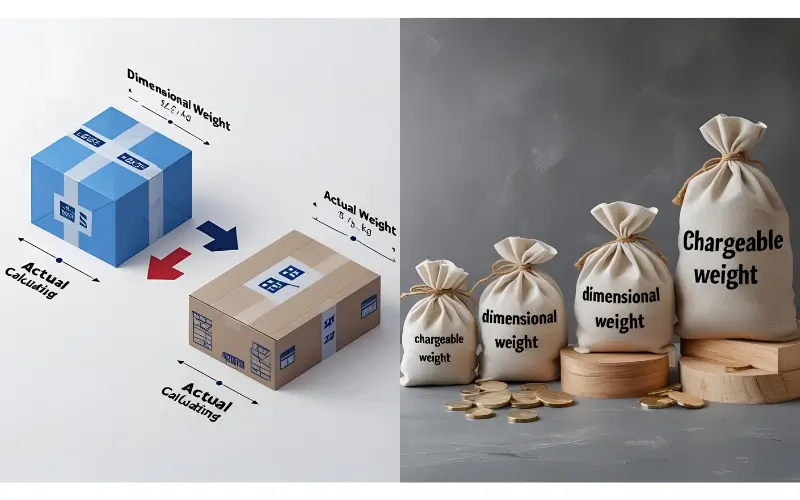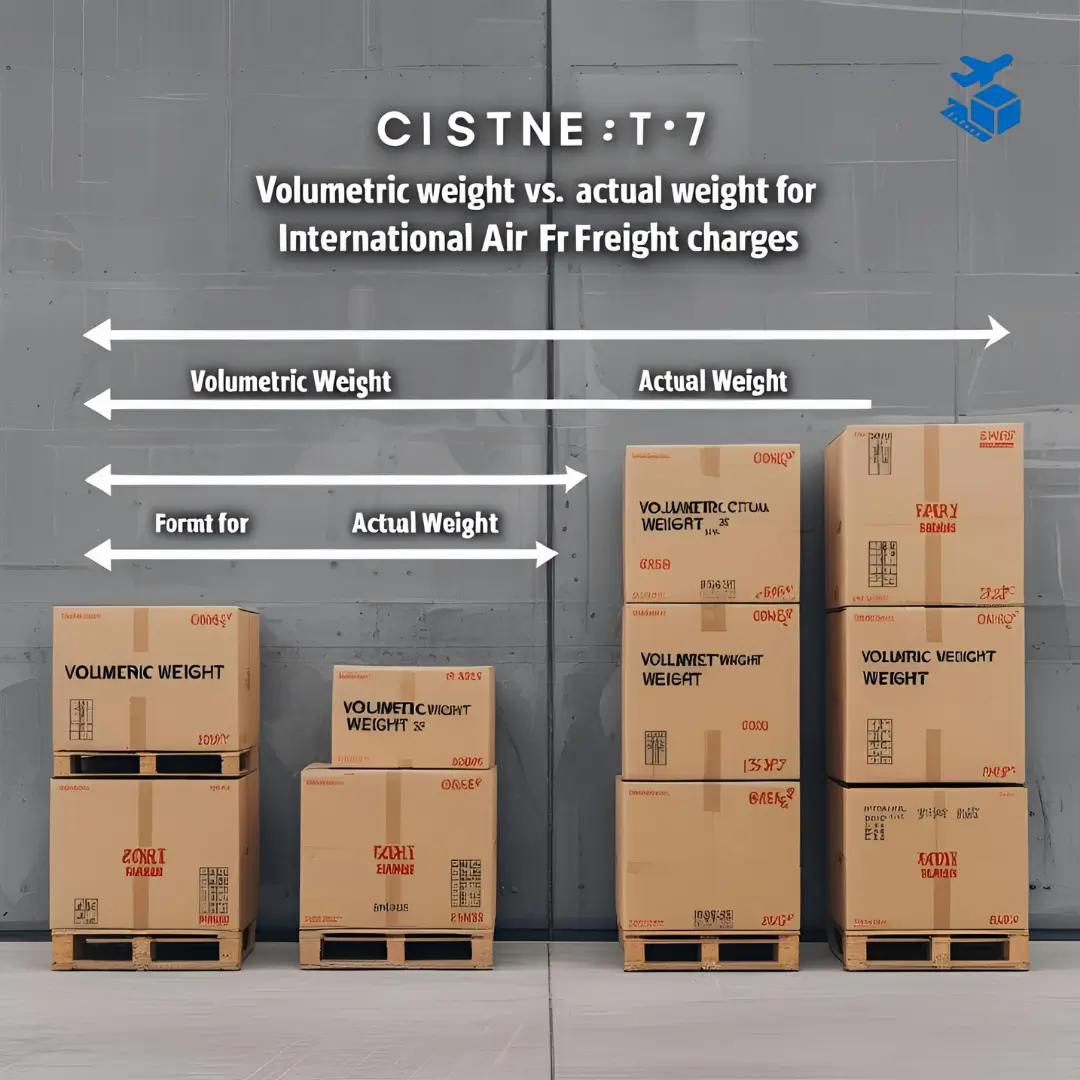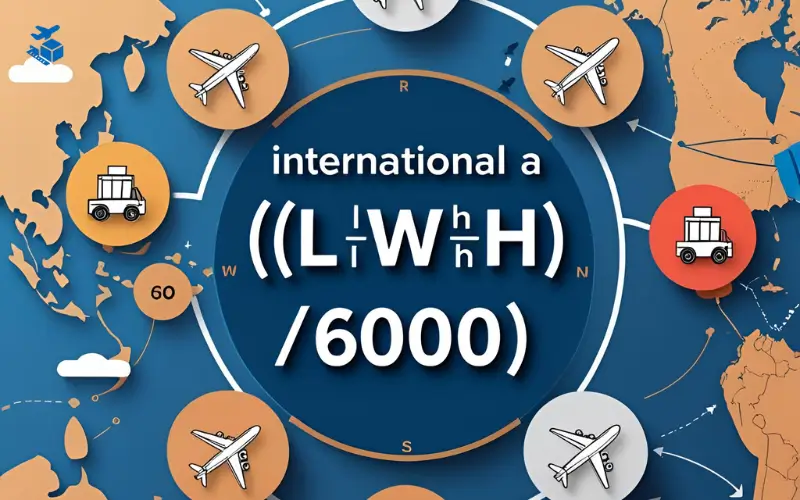Volumetric Weight vs Actual Weight in Air Freight Explained

Volumetric Weight vs Actual Weight in Air Freight Explained: Learn which one affects your shipping cost more—and how to avoid paying for empty space.
As an international air freight forwarder, I often encounter freight rates that differ from my own calculations, leaving me confused.
Of course, experienced salespeople might be less likely to encounter these issues.
We know where the problems are. We simply miscalculated the freight, forgot to convert the billing unit, and sometimes did not ask in detail whether the charge is based on volume weight or actual weight.
The confusion usually comes down to one overlooked detail: not knowing which weight is actually driving the cost.
Is it the actual weight you see on the scale, or the space your cargo takes up in the plane? That’s where a Volumetric Weight Calculator becomes essential.
It’s a common trap—air cargo carriers often charge based on how much space your shipment occupies, not how heavy it is.
Using a Volumetric Weight Calculator helps you avoid these surprises—especially when shipping bulky but lightweight goods that inflate your bill.
The good news? Once you understand how both weights work, you can use a Volumetric Weight Calculator before booking to estimate costs accurately.
We’ll show you how to compare actual and dimensional weight, and how our Volumetric Weight Calculator can help you make smarter, cost-saving decisions.
👉 Avoid overpaying — try our free Volumetric Weight Calculator now.
1. What Is Actual Weight in Air Freight?
Actual weight—sometimes called gross weight—is just what it sounds like: the real, physical weight of your shipment, measured on a scale in kilograms or pounds.
If your box weighs 28 kg, then your actual weight is 28 kg. Simple, right?.
But here’s where many people get caught off guard: airlines don’t just look at the product itself.
The gross weight includes everything—your packaging, pallets, straps, even the wrapping.
That means extra cardboard or a heavier crate can bump up your actual weight more than you'd expect.
To avoid surprises, it’s smart to run your numbers through a Volumetric Weight Calculator.
It helps you compare the actual weight with the dimensional weight and shows you which one will be used for billing.
If we modify the packaging, any changes found in the packaging of the goods will affect the air freight product. This is a good time to use the Volumetric Weight Calculator.
Don’t just rely on the scale—double-check with a Volumetric Weight Calculator before you ship.
2. What Is Volumetric Weight in Air Freight?
Volumetric weight—also known as dimensional weight—isn’t about how heavy your shipment is, but how much space it takes up on the plane.
Airlines don’t just charge by the kilo; space is limited, and they need to make the most of every cubic meter.
The IATA volumetric weight formula most airlines use is:
Volumetric Weight (kg) = (Length × Width × Height) / 6000
- Dimensions are measured in centimeters (cm).
- Some carriers—especially on specific international routes—use a divisor of 5000 instead of 6000.
Example:
If your box measures 80 cm × 60 cm × 45 cm:
(80 × 60 × 45) / 6000 = 36 kg volumetric weight
Even if the actual weight is only 29 kg, the airline will charge you for 36 kg because it occupies more valuable cargo space.
That’s why using a Volumetric Weight Calculator is so important.
A reliable Volumetric Weight Calculator helps you compare weights before shipping—and a Volumetric Weight Calculator can save you from expensive surprises.
3. Why dimensional weight Often Becomes Chargeable Weight
Why do airlines care so much about volumetric weight?
It comes down to fairness and making a profit. Air cargo space is limited, and if everyone shipped light but bulky items, airlines would lose money fast.
That’s why most carriers—DHL, FedEx, and others—charge based on chargeable weight, which means they bill you for whichever is heavier: actual weight or volumetric weight.
To avoid surprise costs, freight forwarders and shippers always use a Volumetric Weight Calculator to double-check both weights.
Knowing the formula for volumetric weight and having a reliable Volumetric Weight Calculator at hand is simply essential in air freight.
Chargeable Weight = The greater of Actual Weight vs. Volumetric weight

Freight forwarders and logistics professionals routinely check both numbers using a Volumetric Weight Calculator to prevent surprises.
Knowing the volumetric weight formula and having access to a chargeable weight calculator is non-negotiable in the air cargo industry.
If you want to stay ahead, make the Volumetric Weight Calculator your go-to tool for every shipment.
4. Example Calculation
Let’s break it down with real numbers:
- Box Dimensions: 85 cm × 55 cm × 35 cm
- Actual Weight: 30 kg
→ Calculate Volumetric Weight:
(85 × 55 × 35) / 6000 = 27.1 kgSince 30 kg (actual weight) is greater than 27.1 kg (volumetric weight), your chargeable weight is 30 kg.
That’s the weight the airline will use to determine your air freight charges.
Using a reliable Volumetric Weight Calculator makes these calculations quick and easy, helping you avoid paying for empty “air space.”
Whether you’re a small exporter or a large freight forwarder, a Volumetric Weight Calculator is an essential tool to keep costs under control.
5. Smart Ways to Cut Down Volumetric Weight
High air freight bills often sneak in because your cargo takes up more space than it weighs.
But there are smart ways to fix that—and yes, it starts with knowing your numbers using a Volumetric Weight Calculator
Here’s how experienced shippers keep volumetric weight in check: Big boxes filled with air? That’s a shipping mistake. Choose packaging that hugs your product without wasting vertical or horizontal space. Trim the fluff—literally. Flat-packing isn't just for IKEA. Disassembling bulky items like chairs, frames, or equipment can drastically reduce the shipping volume. Less volume = lower volumetric weight = savings. Instead of shipping five small boxes, consider combining them into one efficient unit. This reduces total surface area and, in many cases, brings down chargeable weight. Before confirming any shipment, plug your final dimensions into a reliable Volumetric Weight Calculator for air freight. It’s the easiest way to spot potential savings—and avoid billing shocks later. 👉 Want to know your savings? Use our Volumetric Weight Calculator.
🚫 Say No to Oversized Packaging
🔧 Break It Down
📦 Bundle Smarter
6. The Smarter Way to Calculate Air Freight Charges
Gone are the days of scribbling formulas on paper or pulling out a calculator.
Today’s freight professionals rely on Volumetric Weight Calculators that do all the heavy lifting.
Whether you're estimating your air cargo chargeable weight or just checking if your shipment will be billed by size instead of weight, the right tool makes all the difference.
These calculators instantly compare:
- Actual weight (from the scale)
- Volumetric weight (based on dimensions)
- Chargeable weight (the one you pay for)
They also factor in the correct divisor (6000 or 5000), which can vary by airline or route—something that’s easy to miss if you’re calculating manually.
With a good Volumetric Weight Calculator for air freight, you're not just saving time—you’re avoiding costly errors.
For exporters, e-commerce sellers, or logistics teams working under pressure, it’s a tool you’ll be glad to have open in your browser.
7. Costly Mistakes Shippers Still Make
Even experienced logistics teams slip up when it comes to air freight billing. Here are some of the most common errors—and how to avoid them:
| ❌ Mistake | 💸 What It Might Cost You |
|---|---|
| 🚫 Mixing Units | Using inches instead of centimeters can dramatically inflate your dimensional weight. Always stick to metric when using a Volumetric Weight Calculator. |
| 🚫 Assuming All Airlines Use the Same Formula | Not all carriers apply the same volumetric divisor—some use 6000, others 5000. That small difference can shift your chargeable weight. Double-check your airline’s policy. |
| 🚫 Skipping the Comparison | Thinking “actual weight is lower, so I’m fine” is a rookie mistake. You must compare both actual and dimensional weight. That’s where a chargeable weight calculator becomes essential |
Using the right tools—and avoiding these classic pitfalls—can save you from surprise charges on your next shipment.

Frequently Asked Questions
1. What is the difference between dimensional weight and actual weight?
Actual weight is the physical mass of a shipment measured on a scale, while volumetric weight (also known as dimensional weight) reflects how much space the cargo occupies. Airlines charge based on the higher of the two to maximize aircraft space usage.
2. Why do we divide by 6000 to calculate volumetric weight?
The divisor 6000 comes from the IATA (International Air Transport Association) standard formula:
Volumetric Weight (kg) = (L × W × H) / 6000.
It converts the volume (in cubic centimeters) into an equivalent weight, assuming 1 cubic meter equals 167 kg. Some carriers, however, use 5000 for higher billing density.
3. Can volumetric weight be less than actual weight?
Yes. If your shipment is very dense (heavy but small in size), the actual weight will exceed the volumetric weight. In such cases, airlines will charge based on the actual weight, as it represents higher cost to carry.
4. What is chargeable weight in air freight?
Chargeable weight is the final billing weight used by airlines. It is the greater value between actual weight and dimensional weight, ensuring fair pricing based on cargo density and space utilization.
5. What is the difference between volumetric weight and CBM?
CBM (Cubic Meter) is a unit of volume (L × W × H in meters), commonly used in sea freight. dimensional weight converts that volume into a billing weight using a divisor (usually 6000 or 5000) for air freight. They are related but used differently across transport modes.
6. How to calculate volumetric weight for air freight?
Use the formula:
Volumetric Weight (kg) = (Length × Width × Height in cm) / 6000
If the result is higher than the actual weight, this becomes the chargeable weight. A Volumetric Weight Calculator automates this process accurately.
7. Why is it important to understand volumetric vs actual weight?
Knowing the difference helps avoid unexpected shipping costs. Low-density cargo can trigger high volumetric charges, even if it's lightweight. Understanding this allows better packaging and smarter freight decisions.
8. How to reduce volumetric weight and save on air freight?
To reduce volumetric weight:
- Use compact packaging
- Eliminate excess padding
- Disassemble large items (e.g. flat-pack furniture)
- Consolidate multiple packages into fewer boxes
Each strategy helps reduce volume, lower costs, and improve your chargeable weight efficiency.
8. Final Thoughts: Why This Calculation Matters
When it comes to air shipping, Volumetric Weight vs Actual Weight in Air Freight Explained is more than just a logistics topic—it’s a direct impact on your bottom line.
Misunderstanding how chargeable weight works can lead to unnecessary costs and strained margins.
To stay ahead:
- ✅ Always run both numbers—your actual weight and your dimensional weight
- ✅ Use a reliable Volumetric Weight Calculator to take out the guesswork
- ✅ Double-check the divisor (5000 or 6000) used by your specific airline
- ✅ Talk to your freight partner before confirming any shipment
At the end of the day, smart shipping is about more than packing boxes—it’s about making informed decisions with the right tools.
Master the use of a Volumetric Weight Calculator, and you won’t just save money—you’ll ship smarter, faster, and with confidence.
Mastering these calculations—and using a Volumetric Weight Calculator—helps control costs, satisfy clients, and stay competitive in global logistics.
Written by certified international freight forwarders
Related Articles
- Chargeable Weight in Air Freight: Quick Answer & How to Save
- How to Calculate Volumetric Weight for Air Freight Easily
- IATA Volumetric Weight Calculation: Air Freight Billing Guide
👉 Try our free Volumetric Weight Calculator now and ship smarter.
